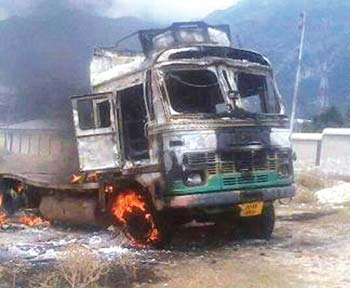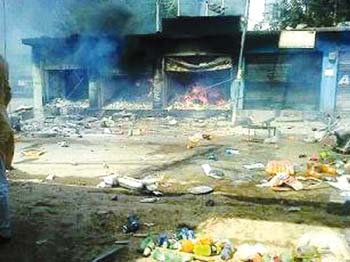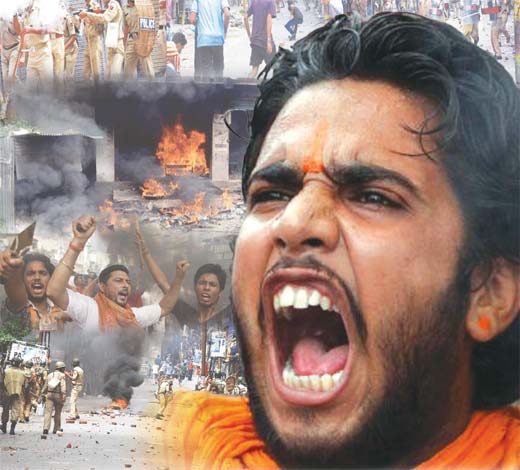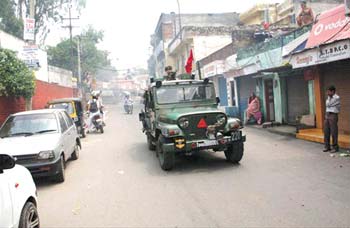Worst communal clashing on Eid led to three brutal deaths, massive property loss and visible gulf between the two communities in Kishtwar. As the dust is settling over the mess after many heads were made to roll, it seems the plot was political and stakeholders have won part of the game, at least for the time being, a Kashmir Life analysis.
In the main market of Gulabgarh (the other Gulabgarh is in Ramban’s Gool), in the faraway Padder Valley, Javed M is known to everybody. The reason being, that he is perhaps the only Muslim shopkeeper in the village. Within hours after clashes broke out in Kishtwar, he was politely told to stay away. He followed the diktat. In his absence, a mob came, unlocked his hardware store, brought out everything, looted it and set things afire. It marked the beginning of extension of Kishtwar communal conflagration to the region, known much for the elusive Sapphire crystals than visible virulent communalism.
The 63 km zigzag trek to Valley passes through the edges of mountains, garlanding the peaks and snaking around fascinating meadows. Midway visitors seem to be leaping out of the time-machine to witness residents living in Kudus, the cave-houses which some have dug out in softer rocks or are naturally made under the shade of huge boulders. Abject poverty is visible and the remoteness is prolonged by mountain passes that even a telephone call takes a couple of minutes to mature.
That explains why Padder was an uninhabited meadow till the eighth century. Then the herdsmen from Lahol (Himachal), Zanskar (Ladakh) and Bhaderwah (Doda) settled there. For most of the nineteenth century, it was part of Zanskar till Ranbir Singh annexed it with Kishtwar tehsil. In 1963 it became a block and very recently 32 hamlets falling in five Panchayat’s became a tehsil. There are Muslims, Hindus and Buddhists. Muslims barely make 10% of the population.
But the remoteness has not prevented people from becoming fanatical in the display of assertive religiosity. This summer explained the extent to which it could lead. After doing away with Javed’s assets well before the Friday afternoon prayers, the mob trekked to Atholi, resorted to stone pelting at a few places and returned. If one goes what the Kishtwar population informed the district administration, the Bajrang Dal Bolero jeep with press stickers and a message from Kishtwar might have reached the mob at Atholi itself. That was Friday.
The weekend witnessed massive mobilization of the majority community and a huge procession was taken to Kijaie, a Muslim majority village near Atholi. They had already plundered parts of neighbouring Karthie. In Kijaie, they faced resistance as Muslims engaged them in fist fighting. With police and civil administration watching, the Village Defense Committee (VDC) and Dhok Defense Committee (DDC) men accompanying the procession opened fire. Three youth were hit; Mushtaq, Altaf and Imtiaz. Two were hit in their legs and one in chest, all by bullets.
Locals said the state arming of civilians has tilted the odd balance further; it is 1600 guns of Hindus versus 6 of Muslims in Kijaie.

Somehow the injured were shifted to Atholi hospital where doctors said the trio must be shifted to the district hospital in Kishtwar. An ambulance was arranged for transporting them to the helipad in Gulabgarh. A chopper had taken off from Jammu for fetching the casualties. Some family members of the injured were accompanying them. As the ambulance reached closer to the helipad, the mob attacked the ambulance. The attack was so severe that Ghulam Rasool Khanday aka Lassa Khanday jumped out of the ambulance and fled only to be caught by the mob. Now witnesses said identified people from VDC/DDC actually took away him by force.
As cops somehow rescued the injured and took them to the police station and asked the chopper not to land, the mob attacked the police station injuring at least two officers. Late in the evening when the police and the administration sent a unit of the army to rescue the “stranded” pilgrims of Machail yatra, somehow the injured were also transported to Kishtwar only to be shifted to Udhampur later. It coincided with the discovery of the dead body at the helipad that was later identified as that of Khanday. Interestingly, it was a Hindu who broke the news to a Muslim in Kishtwar! Was Khanday shot or lynched to death is a matter of investigation now.
Swiftness was the hallmark of this crisis. Even people in Kishtwar are unable to understand why Gulabgarh started reacting as those in town were trying to get details of the happenings. They even believe Rajnath Singh was well informed than Omar Abdullah at that point of time! But how? People who witnessed the main trouble around Kishtwar’s 165 acre Chowgan grounds – the epicenter of the town’s socio-political and to an extent political upbringing for centuries, on Friday are perplexed how the crisis became so huge a hit, almost instantly.
Only a fair investigation can unravel a conspiracy angle if at all it existed. But the beginning of a mess has been simple. There are no disputes over one thing that villagers in hoards started coming towards the Chowgan for Eid prayers. They all were reciting the religious hymns loudly.
Right-wing BJP and part of the government has been claiming that the people came shouting anti-India slogans. They have reference to a 2012 video that the district SP who was shifted last week had filmed when he was on probation in the town. But a cross-check at various levels suggests the groups’ arrival for Eid prayers is an old practice in the region. And their arrival is no silent affair. Communities in the region have been asserting their religious identity throughout. Muslims even have the tradition of unfurling a green – not Pakistani green, flag on every Eid!
Most of the accounts suggest that the trouble erupted near Kuleed Chowk when a motorcycle-borne individual (a policeman who is part of a BJP official’s security detail) wanted to overtake one of these Muslims processions and would blow horn repeatedly that irked some of the faithful. Verbal duels led to fist fighting, slogan shouting, stone pelting and then guns and rioting.
As part of the Muslim crowd stayed engaged in the stone pelting some of them went to Chowgan to inform the larger gathering. Occasional tear gas bursts and a few rounds in air had adequately informed the people of the trouble. The turning point came with a shower of stones in a corner of Eid grounds at a time when the Imam was reciting Khutba, marking the end of the prayers, almost instantly.

With prayers over, there was chaos everywhere. People started fleeing to their homes with their kids and the youth started attacking Hindu properties. It had actually started from Kuleed itself when an LPG dealer’s shop was set afire. In reaction, Hindus set afire a hotel and a petrol pump. It was there when the first casualty of the crisis took place – Arvind Kumar. He had no bullet but had a lot of pellet injuries. It is a matter of investigation as to who had fired at him – the Muslim mobs or the police. After plunder in Malik market, the first phase of rioting completed with the destruction of the wine shop near the bus stand.
Retaliating to Arvind’s death, a Hindu mob intercepted Bashir Ahmad, a handicapped youth working for PHE, and brutally killed him before putting him on fire. His roasted body was later identified by the un-burnt shoes.
After a lull, the rioting started again. Police are investigating how it reoccurred. Popular versions are that promoter of Amar Market allegedly took a youth and shot at him. The youth survived with an injury in the thigh and in its retaliation the Amar market went up in flames. A senior medical doctor who lives nearby is accused of opening his guns on a mob that led to many injuries. In retaliation, locals say, a multiplex owned by Kichloo family was attacked. The looters were very selective – they did not touch any Hindu shop in the complex and instead broke open locks of a gun shop. They looted all the guns and took all the ammunition. This was the last incident. No more violence was reported from the town.
Authorities were witness to almost all the incidents. State’s Home Minister Sajjad A Kichloo who is also the local MLA was putting up in the town. The police had quite a few people to manage the crisis. So was the problem with the army. Till the two forces managed the people, Kishtwar was almost burnt. (Read Sajjad Kichloo’s first-person: His Blaze Version). The overall losses include 68 shops, seven hotels and 35 vehicles which went up in flames. Authorities have already announced a compensation pattern for the dead, injured and the damaged property. Right now the issue is how to prevent a section of the trading community from not migrating.
But if people at high offices claim they had no indication of the deterioration in the situation, are wrong. Even the state police intelligence had reported clearly that things are getting bad in Chenab valley. There were clear signs of a simmering discontent in the last few weeks, especially during the month of Ramzan.
Soon after the Gool killings, most of the Chenab valley started reporting nocturnal stone pelting on Muslim houses in all the three districts – Kishtwar, Doda and Ramban and large-scale harassment. Behind this harassment were “mysterious” people who would barge into the homes, scare the inmates and flee with such swiftness that nobody could actually catch hold of them,
This phenomenon dubbed as “ghost culture” was reported during the early days of militancy from Kashmir as well. In fact a couple of murders took place in a few summers and the killings were attributed to the “ghosts”. With nobody able to confirm but all these actions were attributed to the security agencies in the name of night dominance. Many think it is part of the trainings. Similar raids were reported from the villages of Pathribal in 2000 at the time of the worst fake encounter for which CBI finally held the army responsible.
There were three instances in which the people guarding their habitations caught these “ghosts”. The last instance was in Pranu village of Doda where they caught some people and handed over to the police. The police set the “ghosts” free and arrested the people who had caught them. These vigilantes were set free only after massive protests broke out.
Even in Chatroo, residents caught a gang of “ghosts”. They fought back and rendered a forester Abid Hussain injured. But the villagers managed their capture and handed them over. They were identified as Territorial Army men and let free because “they were on night patrolling”.
The latest instance took place in Bhagwa village in Doda outskirts only on the eve of Eid. Baghwa resident Farooq Ahmad said they were responding to frantic cries for help in the middle of the night by an elderly person who claimed he was beaten by some people while he was asleep in his room. The people came out in thousands and caught a sumo in the outskirts of the neighbouring village by blocking the road.
The restive villagers sounded the administration of their catch and by 3 PM, Deputy Commissioner and SP Doda and lot many officers were in the village. After prolonged negotiations with the people, they took all the 10 people including driver Anil Kumar with them. Ten of them were soldiers.
SP Doda Arif Reshu said the police are investigating the case. “Yes, we got a number of soldiers with us and they are saying they were part of a patrol in the belt,” Reshu said. “We have received no formal complaints against them.”
Residents, however, said the police are not involved in these enigmatic nocturnal scaring operations but they are not preventing the security agencies from resorting to these tactics. “Police is definitely part of the hush-up,” a Doda lawyer said.
A general belief in the region is that these are night exercises by the security agencies which are being carried out with the help of Village Defence Committees (VDC).
While people had somehow reconciled with the excesses of the VDCs in the region, a recent gang-rape adversely contributed to the discontent. During the intervening night of July 24 and 25, four youth related to a powerful VDC member kidnapped a minor Bhatkot girl and gang-raped her. It triggered protests making police to act quite fast. But arrests did not reduce the pain of the people. Within two days, VDC was accused of killing a tenth standard boy Shamim Ahmad Lone in Thathri’s Thipsu village. Though the charge is yet to be proved, it added to the overall tensions in the region.
VDCs have remained a perpetual crisis ever since they were set up as part of the BJP’s blackmail in 1994. BJP launched a massive movement in the region and offered 14000 voluntary arrests in 1994 summer to pressurize the gubernatorial regime to declare Doda as disturbed area. The government did not agree to the demand but ended up offering VDC instead which started operating on October 1, 1995. L K Advani, who then was leading the Abhiyaan, agreed to it. Six years later when Advani was the home minister, he presided over a security meeting on August 8, 2001, and declared the entire Jammu including Chenab valley disturbed!
VDCs are extra-constitutional entities under which the security grid identifies volunteers who will get trained, be armed and fight militancy. Initially, a few hundred committees were set up. Majority Muslims were denied any entry into it and later when they sought their share they were denied. At the end of the day, VDC are by and large Hindu armed gangs that have access to power without accountability. Their fight against militancy is a suspect as their exploits are a huge suppression story. With every militancy related incident triggering additions of VDC, it has become a huge army in itself.

NGO J&K Coalition of Civil Society stated that Kishtwar has 3287 VDC members and 3174 of them are Hindus. Neibhouring Doda has 6521 VDC members including 5874 Hindus and Ramban has 2901 VDC members of whom 2697 are Hindus. These three districts make the Chenab Valley. But the government stated in the state legislature on March 9, 2012, that there are 12753 individuals working for VDCs in the three districts including 10041 VDC members and 2712 SPOs.
The situation has triggered a massive appetite for the weapons. In last two years when the state government issued 51622 gun licences, the Chenab Valley had the lion’s share – 31006. Some of these weapons did found use in the skirmishes.
Systems for managing the VDC also changed and improved. Initially, they were given five live rounds of ammunition. Once they would use it and offer records, they would get more. Soon after the Kulhand massacre of Hindus, MHA led by Shivraj Patil approved offering 50 live rounds. Initially, the policy was that if VDC men kill a militant, they will be officially permitted to keep the weapon. Since they could not do anything spectacular, it was Patil who took the policy decision of giving them automatic weapons, wherever required. Most of the VDC have now SLRs and not vintage 3.3s.
“A senior police officer whose identity I would not tell you told me that the police have no record of which arms were allotted to which VDC and when?” engineer Abdul Rashid Sheikh, who was stopped by VDC in the periphery of Kishtwar recently said. “I saw them carrying AK 47 as well as vintage 3.3 rifles.”
Though the crisis was communal, the plot was clearly political, Chief Minister Omar Abdullah said accusing the right-wing BJP for it. Even the central intelligence agencies have held Bajrang Dal responsible. But the complex game-plan was aimed at plain arithmetic.
The larger goal was to create enough of polarization that part of Hindu vote consolidates and creates a 2008 situation that fetched BJP 11 seats. BJP faced internal bickering as it was caught helping Congress in Upper House voting as a result of which seven of the lawmakers were sacked by their own party. BJP is desperate to have something spectacular so that it retains its share in the region.
Chenab Valley with mixed population has remained a crucible for the right-wingers along with Rajouri and Poonch. Post militancy, they would intervene as part of the system – VDC-SOG-Army. After a very long time, their activities were checked by a local lawmaker who became the home minister. The first major shock to them was the arrest of Shiv Kumar alias Sonu who was right-winger’s hero in the region. That was perhaps why the BJP cadres and leaders from Jammu to Delhi reacted to the arrest that was no normal to every other person in the state. His crimes are so deep that no court is willing to grant him bail. So Sajjad A Kichloo was to be targeted and it proved a clean operation.
But Congress had its own role in unseating Kichloo. Kishtwar is the only constituency in Chenab Valley that is with NC. The rest four segments are with Congress. In fact, it was G M Saroori from neighbouring Inderwal constituency who was the minister till he was sacked for an academic racket involving his daughter. Since he was not taken back to the council of ministers, Kichloo’s entry – he took over in January 2013, upset the balance. So Congress wanted him out. And, more importantly, Omar Abdullah was under pressure to make some sacrifice to help right-wingers feel satisfied that Sajjad became an easy option.



















History stands testiment that 5lakh muslims were massacred in jammu region in 1947-48 by hindu rulers so as to dilute the muslim population in jammu. what can we expect now from these